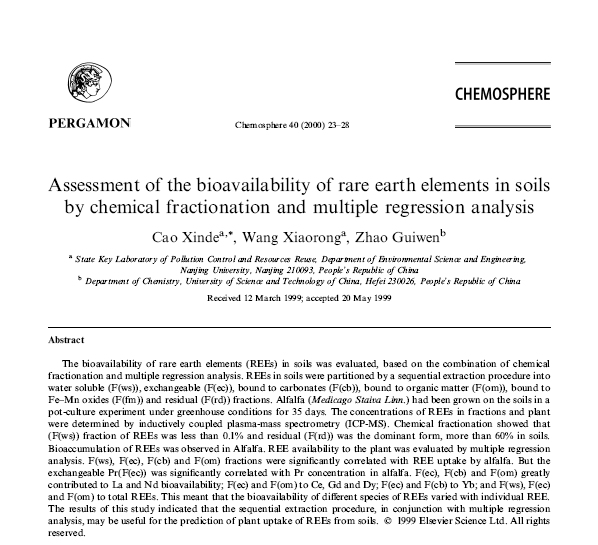Assessment of the bioavailability of rare earth elements in soils by chemical fractionation and multiple regression analysis
2017-11-27
Cao Xinde, Wang Xiaorong, Zhao Guiwen
Abstract
The bioavailability of rare earth elements (REEs) in soils was evaluated, based on the combination of chemical fractionation and multiple regression analysis. REEs in soils were partitioned by a sequential extraction procedure into water soluble (F(ws)), exchangeable (F(ec)), bound to carbonates (F(cb)), bound to organic matter (F(om)), bound to Fe-Mn oxides (F(fm)) and residual (F(rd)) fractions. Alfalfa (Medicago Staiva Linn.) had been grown on the soils in a pot-culture experiment under greenhouse conditions for 35 days. The concentrations of REEs in fractions and plant were determined by inductively coupled plasma-mass spectrometry (ICP-MS). Chemical fractionation showed that (F(ws)) fraction of REEs was less than 0.1% and residual (F(rd)) was the dominant form, more than 60% in soils. Bioaccumulation of REEs was observed in Alfalfa. REE availability to the plant was evaluated by multiple regression analysis. F(ws), F(ec), F(cb) and F(om) fractions were signi®cantly correlated with REE uptake by alfalfa. But the exchangeable Pr(F(ec)) was signi®cantly correlated with Pr concentration in alfalfa. F(ec), F(cb) and F(om) greatly contributed to La and Nd bioavailability; F(ec) and F(om) to Ce, Gd and Dy; F(ec) and F(cb) to Yb; and F(ws), F(ec) and F(om) to total REEs. This meant that the bioavailability of different species of REEs varied with individual REE. The results of this study indicated that the sequential extraction procedure, in conjunction with multiple regression analysis, may be useful for the prediction of plant uptake of REEs from soils.
